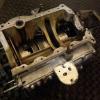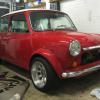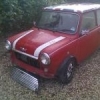
Water Cooled Manifold
#1

Posted 13 June 2012 - 09:16 PM
Like all teenagers he wants the big exhaust ,which means big exhaust manifold and a water cooled inlet manifold which have been fitted and are ok,
but how do I plumb in the inlet manifold ?. At first I thought the pipe coming from the heater would be routed through it but if the heater is turned off would that stop the flow? any help would be appreciated . Thanks Andy
#2

Posted 13 June 2012 - 09:21 PM
#3

Posted 13 June 2012 - 09:22 PM
With an 850 the largest exhaust you should fit is a 1.625" internal diameter. Any larger and some of the small amount of power an 850 has will be lost due to exhaust inefficiency. Even that size can be a bit too large at low to mid-range revs and high revs will be needed to make it work well.
Edited by Cooperman, 13 June 2012 - 09:24 PM.
#4

Posted 13 June 2012 - 09:35 PM
#5

Posted 13 June 2012 - 09:52 PM
I wonder if you'll get flamed for saying that there is no need for a heated manifold, Cooperman. Maybe it was because I'm younger means that I cannot know what I'm talking about?
???
#6

Posted 13 June 2012 - 09:58 PM
#7

Posted 13 June 2012 - 09:58 PM
#8

Posted 13 June 2012 - 09:59 PM
So I'd say it's not actually a necessity, but it's still worth plumbing it in.
I can't really help with the plumbing on a 1980 model I'm afraid, as I've only ever plumbed one in on a later model where the heater inlet valve is at the bulkhead and the heater circuit take off is taken from a sandwich plate beneath the thermostat housing. This makes it much easier to take a separate feed off of the heater take off hose, before it enters the actual heater circuit itself.
I suppose you might be able to fit a sandwich plate beneath the thermostat housing on an earlier model, giving you a separate feed for the inlet manifolds plumbing and then also fit a later type bottom hose that includes the additional take off for a heated manifold outlet??
Edited by AVV IT, 13 June 2012 - 10:07 PM.
#9

Posted 13 June 2012 - 10:23 PM
Ideally you would have a thermostat that worked in the opposite way to the engine thermostat, cutting off the water supply once the engine was warm, when there is no need to heat the manifold.
#10

Posted 13 June 2012 - 11:34 PM
I always think it was just one more rather odd thing that Austin/Rover did, like mixing brake connections imperial & metric, rubber mounting the front sub-frame to the detriment of handling, etc.
#11

Posted 14 June 2012 - 10:15 AM
I have thought about this, and consider that the old-fashioned hot spot, where the inlet and exhaust manifold castings are joined, used to achieve the required result fairly quickly after engine start, but when the engine was working hard would be far too hot, and cause a significant power loss. The water temperature, being controlled by the thermostat, is more stable and predictable. Which leads me to my next thought, about how the manifold should be plumbed in to the cooling system. Ideally it wants to get as much hot water as is available quickly, before the thermostat opens. After that, when the engine is warm, it is not so important. So, its hot side should be fed from below the thermostat, the cold obviously returning to somewhere near the bottom of the system, e.g. T piece into the existing heater stub on the bottom hose. That may help answer the original question.
I had a Metro engine in one of my Minis, and I seem to recall that it had an outlet, maybe on a sandwich plate below the thermostat, which would seem to be the correct place for connecting the manifold heating system. I can't confirm that, as I don't have a Metro manual, and never saw the engine actually in a Metro.
My old Ford Focus TDi had an electric heating element in the water circuit, supposedly to get the demisters working quicker. Maybe adding one of these in the water feed to the manifold would gain some advantage on warm-up time?
#12

Posted 14 June 2012 - 10:26 AM
I had a Metro engine in one of my Minis, and I seem to recall that it had an outlet, maybe on a sandwich plate below the thermostat, which would seem to be the correct place for connecting the manifold heating system. I can't confirm that, as I don't have a Metro manual, and never saw the engine actually in a Metro.
http://www.minispare...|Back to search
Like this? They're used in 90's on mini's for a heater take off and to eliminate the bypass hose.
#13

Posted 14 June 2012 - 11:04 AM
I thought my point was that when you use water heating you don't need a hot spot, perhaps that was not too obvious. If you have a modified exhaust system, with manifold fabricated from tube, you don't have the option anyway.
As for heated front screens, yes, they are the right thing to do, and I know that you can get then for Minis. I think that if you have one you will be MOT legal even if you strip out the heater. (Actually, not sure about whether the MOT would care, but you probably need a means of demisting to satisfy Construction and Use Regs, depending on the age of the car, and would definitely need one if it had to go for IVA.) My Focus had a heated front screen, and the heating element in the water feed, which when I think about it does not make a lot of sense, so I could have misunderstood, and the electric element was there to warm the passengers, not the windscreen (which it did not do particularly well).
At least we seem to be agreed about the OP's question, the manifold should be plumbed into the heating circuit. On a Mini, I would think that T pieces into both heater hoses would be the easiest thing to do for a retro-fit.
#14

Posted 14 June 2012 - 11:17 AM
#15

Posted 16 June 2012 - 08:15 AM
1 user(s) are reading this topic
0 members, 1 guests, 0 anonymous users



















